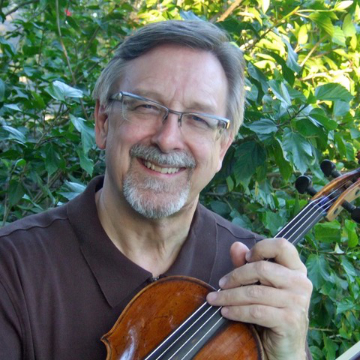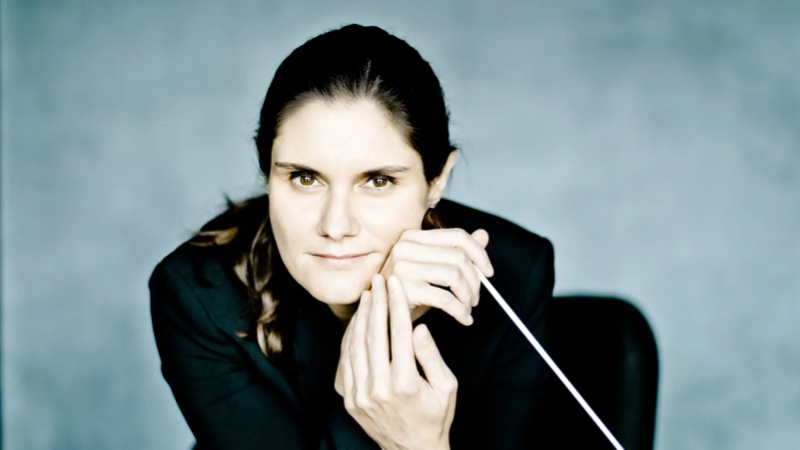ROCO’s ‘Feels Like Home’ featured four world premieres, a Texas premiere, and Emilie Mayer’s rediscovered Symphony No. 4, led by Delyana Lazarova.
ROCO, a 40-piece chamber orchestra in Houston, continued its Season 21 with four ROCO-commissioned world premieres and the Texas premiere of a recently reconstructed symphony by Emilie Mayer. Titled “Feels Like Home,” the concert was led by conductor Delyana Lazarova at Miller Outdoor Theatre. ROCO continued its use of screen projections and camera work of the musicians and conductor, along with a phone app that guided listeners through the pieces. Additionally, Lazarova spoke about the works in a personable and informative manner. Serving as guest concertmaster was Margaret Batjer, concertmaster of the Los Angeles Chamber Orchestra and director of the Colburn School’s Music Academy.
Heather Schmidt’s newest ROCO-commissioned work, Husky Chronicles, “is a tribute to resilience, loyalty, and the joy carried by these beautiful animals.” Schmidt has started two husky rescues, which have saved and adopted out over 1500 huskies.
Husky Chronicles is written in a tonally familiar musical vernacular. As with many works by contemporary composers, it has a cinematic quality, as if written to accompany a visual representation or film. This is now heard so frequently that I would identify this genre as a tone picture.
Lazarova led the ROCO musicians in a thoughtful and sensitive interpretation. Schmidt’s expert orchestration was well-projected in this outdoor venue by means of individually miked instruments, but did not have the blend and tonal beauty I heard in Thursday’s rehearsal at The Church of St. John the Divine.
Another tone picture, Starr Parodi’s Riptide, has a visual reference based on her personal experience of riding a riptide in Tahiti. She felt joy, elation, and terror, along with a connection with the surrounding incredible fish as the current swept her away. Forced to let go, she came out the other side okay. This experience informed the loss of her home in the Palisades fire of last January. The piece is “a musical meditation shaped by her experience through personal moments of resilience and surrender, where she found hope in the unknown and strength in letting go.” Riptide conveys a wide range of emotions that are readily felt by the listener.
ROCO Season 21 composer-in-residence Kevin Lau has written At the Still Point of the Turning World, a concertino for ROCO principal clarinet Nathan Williams. A collaborative effort, the work embodies the hospice and palliative care work of Williams. In their discussions, they talked of the importance of being “in the moment,” along with mindfulness and meditation. This brought up Four Quartets by T.S. Eliot, specifically the first poem, “Burnt Norton,” with its description of a perfect moment when everything is exactly as it should be.
The piece begins somberly with the lowest instruments playing a B minor triad. The clarinet joins the texture without interruption or fanfare, with the music gradually unfolding. Williams played sensitively, skillfully projecting warmth and empathy as the music transformed into optimism and hope. A solo cadenza was a reflection of music Williams has shared at the bedside of hospice patients. A piano solo then changes the mood, leading to a conclusion in F major, the key farthest away from the opening B minor. Exactly as it should be.
Steve Vai played guitar in Frank Zappa’s band and later with David Lee Roth. He is a three-time Grammy Award winner and a fifteen-time nominee. Salamanders in the Sun was written in 1984 and has been performed by Vai with a full orchestra. Mark Buller rescored it for chamber orchestra. The electric guitar soloist this evening was Sebastian Cure. Being a rock music piece, it is a very different style and genre from the usual concert works, and shows ROCO’s flexibility and inclusive approach to programming.
German composer Emilie Mayer (1812-1883) has been called “the Female Beethoven.” Given the time period in which she lived, Mayer’s choice to pursue composition as a woman was unusual, if not courageous. Her compositional style bridges the Viennese classical and Romantic periods. Written in 1850, her Symphony No. 4 in B minor was recently reconstructed by Andreas N. Tarkmann. Running triplets in the turbulent first movement have echoes of Mendelssohn, while the highly expressive second movement harkens to Schubert. The third movement, Scherzo, is well-constructed, if a bit lacking in musical tension. A section with Scottish-sounding bagpipes adds interest. The Rondo-form Finale is formally similar to those of Mozart and Beethoven, replete with fermatas and agogic accents. Several violin solos were expertly played by Batjer. Lazarova’s conducting was engaging– energetic, with attention to detail. It was good to hear music from this neglected composer again. It was also good to see Lazarova back on the podium.
A concert consisting only of premieres is rarely, if ever, done, yet such adventuresome programming is common for ROCO concerts. We forget that every piece, even Beethoven’s Fifth, had a first performance. Composers need to have their music performed, and audiences need new works for the art form to stay fresh and grow. Kudos to ROCO.
The concert was repeated at The Church of St. John the Divine on Saturday.

Lawrence Wheeler was a music professor for 44 years. He has served as principal viola with the Pittsburgh Symphony, Minnesota Orchestra, and Houston Grand Opera Orchestra, and guest principal with the Dallas and Houston symphonies. He has given recitals in London, New York, Reykjavik, Mexico City and Houston, and performed with the Tokyo, Pro Arte and St. Lawrence string quartets and the Mirecourt Trio. His concert reviews have been published online on The Classical Review and Slipped Disc.


Leave A Reply